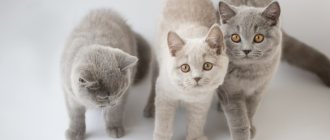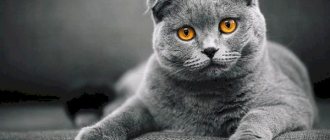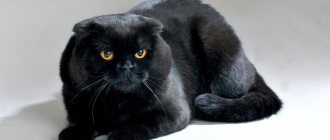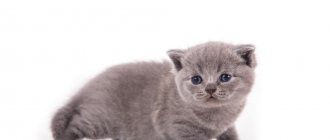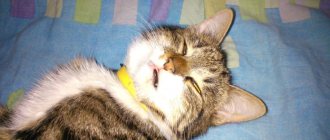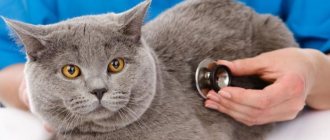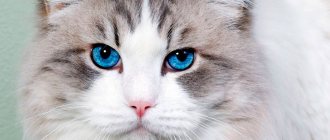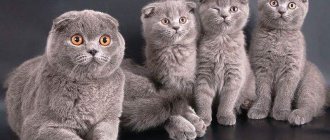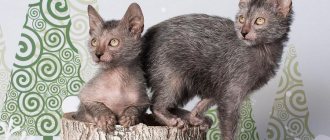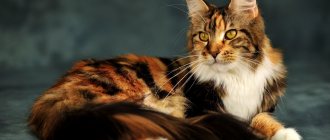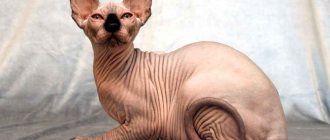History of the breed
The first modern evidence of the existence of fold-eared cats was provided in 1959 in Scotland. Although back in 1796, one of the English scientific journals reported on amazing cats with unusual ears living in China. In 1978, the North American CFA developed its breed standard, however, the FIFe (International European Federation) has not yet recognized the Skotish Fold. The stubbornness of Europeans did not prevent cute creatures from taking part in exhibitions and gaining a large number of fans.
Appearance
The cat is of medium size, strong, harmonious build. The coat is short, thick, elastic, very soft to the touch, elastic, lying close to the body. The color can be very diverse: single-color (blue, black, white, sand, chocolate (milk chocolate color), cream), multi-color (harlequin, van), striped (various tabby patterns, marbled, spotted, brindle).
There are several groups of Scottish Fold colors that differ in the color and nature of the stripes and spots:
- Solid (solid). This is a plain color of the body without any patterns. Cats can be black with shades ranging from jet black to taupe, blue, white, gray, red, sand, chocolate (milk chocolate color) and cream.
- Smoky. Such cats have a uniform guard hair color and a silvery undercoat.
- Tortoiseshells. Characterized by a chaotic arrangement of various spots, rich colors (red, cream and black). It is important that the colors are harmoniously combined and the spots are evenly distributed throughout the body.
- Chinchilla. The color is characterized by the fact that one eighth of the hair is colored, the rest remains white.
- Tabby. This color is characterized by the presence of a brindle, marbled, spotted or striped pattern. Moreover, the nature of the marble pattern suggests a symmetrical arrangement of spots and the obligatory presence on the face of a spot similar to the letter “M”. With the brindle color, parallel stripes of color are located vertically throughout the body. The Whiskas color became especially popular after the Whiskas food advertisement. The main color is silver, the stripes range from dark gray to black.
- Bicolor. With this color, most of the cat's body is white. It is important that the belly, paws, part of the muzzle, neck, chin and chest are white.
- Colorpoint. With this color, the protruding parts of the body are painted in rich colors: paws, tail, muzzle, ears.
The ears are set wide and folded so that their upper part covers the ear opening, that is, they hang down. The more tightly the ears are pressed to the head, the more valuable the representative of this breed is.
The eyes are large, round, open, and set wide apart. The eyes can be of different colors, but must match the coat color. They can be from yellow to amber, blue or emerald. Occasionally you come across cats with different colored eyes - usually white with blue and yellow eyes.
The body is stretched out, graceful, different from the British stocky type. Shoulders and hips are the same width, the chest is voluminous and wide. The legs are of medium length to quite long, strong, with round graceful paws.
The tail is of medium length, thick at the base and pointed at the end. Individuals with a movable tail are valued, since changes in the joints are possible in this breed. Some Scottish Fold cats have bushier and thicker tails. At first this was considered a positive trait. But at the same time, thickening of the hind legs was also observed, which interfered with the cat’s normal gait. Today this sign is undesirable; moreover, it affects the evaluation of the cat and is even a reason for disqualification at the show.
Character
The Scottish Fold cat is a sweet creature with a wonderful character, capable of quickly adapting to a new environment and people. Scottish Folds are very loyal cats and tend to form a very close relationship with one person in the family, whom they will follow from room to room. They need attention and a relationship with their owner.
Despite their loyalty, they are not affectionate or demanding cats and prefer to be close to their owner rather than on their lap. A fold-eared cat only speaks when it wants to say something very important, for example, “feed me,” but even then its voice is usually not loud.
Scottish Fold cats easily adapt to any situation in the house and feel comfortable, both in a room full of noisy children and dogs, and in an apartment with one person. They usually do not panic at shows or in unfamiliar places, and they also get used to other animals very quickly.
They are not hyperactive and obedient animals; there are no problems with keeping such cats. You usually don't have to worry about your pet climbing the curtains or running around the apartment at incredible speeds. However, the Scottish Fold loves to play, especially as a kitten and entertain those present with its strange poses.
Many Scottish Fold cats like to do their own form of yoga, such as lying on their back, sitting in a meditation pose with their paws outstretched in front of them, laying out like a mat, or adopting a chipmunk pose.
Scottish Fold cats can feel lonely if they don't see their beloved owner for long periods of time. In this case, a dog can accompany the Scottish Fold cat.
Socialization
Scottish Fold cats become attached to people very quickly. Experienced breeders claim that they are especially fond of older people and small children. If the Scots really like someone, they will follow him throughout the apartment and try to attract attention to themselves. At the same time, the Scots always know when to stop and will not brazenly jump on their hands, distracting them from business. The main thing for them is just to be close to the owner.
Other cats in the house are not a problem for the Scots. On the contrary, they will be glad to be in good company. Even if a dog lives next to them, they tolerate it calmly. Some fold-eared owners deliberately purchase another animal, most often a dog, so that the cat has a faithful companion in games and home entertainment.
MYTH 2: Scottish cats always have a good character
Morals within this breed are completely different. Many were lucky: they became the happy owners of an easy-going kitten. And mine, for example, is a spoiled princess, and this quality is innate in her, not acquired. And in general, a cat with a capricious, wayward, show-off, demonstrative character. Which cat you end up with is a mystery. Although, of course, it is worth asking the breeder about the character of the kittens born to him. But there is no guarantee that he will tell the truth.
Some breeders have noticed that shorthaired Scots have a tendency towards a more feminine character, especially those with a blue color, as well as blue point and blue tabby: this is explained by the fact that the British genes speak loudly in them. Cats of other colors, for example, bicolors, which have ancestors in America, are softer and more flexible.
In addition, behavior is influenced by factors such as rutting. Males and cats during the period of sexual heat are sometimes more aggressive than in normal times. Therefore, a Scottish cat after sterilization may have a calmer and gentler character than before. Same with the cat.
Health
Genetically, fold-eared cats have many problems. This does not mean, of course, that all of them will manifest themselves in your pet. But forewarned is forearmed!
The first thing that the future owner of a Scottish Fold cat should know about is the skeletal anomalies characteristic of fold cats. The same gene that determines lop ears is responsible for them, so this problem is common.
Osteochondrodysplasia is a hereditary disease that is expressed in skeletal deformation, immobility and pain in the tail, and deformation of the paws. Osteochondrodysplasia, unfortunately, can manifest itself at any age - both in infancy and in the prime of life.
External signs of the disease:
- lameness;
- stiff gait;
- reluctance to jump;
- acute reaction to touching the tail;
- unexpectedly squat appearance of the animal.
To avoid this disease, fold+fold mating should be strictly avoided. Most often, it is the offspring of such parents who are born with a disorder of the musculoskeletal system. It is also worth noting the tendency of representatives of this breed to heart diseases.
Timely vaccinations, visits to the doctor, regular joint examinations, x-rays and proper preventive treatment will help maintain the quality of life of your Scottish. The average life expectancy of these cats is 10-15 years.
MYTH 5: These cats are not very active and not talkative.
Scottish cats are considered to be passive, lazy and calm. In fact, there is a huge space of options. My cat periodically rushes around the house with purrs, jumps on the backs of chairs, and climbs soft objects with the help of her claws. Sometimes he tries to do this at night. And he constantly says something. Not to the same extent as the Bengals, but still. Sometimes talkativeness can be very tiring because the cat comments on everything she does. And he pesters you, pesters you and asks for something.
In general, the cat is hyperactive. Yes, not all Scots are like that. Our second cat is calm. In most cases, when childhood and adolescence pass, the Scots calm down. But even then, among them one can distinguish both active and passive, talkative and silent. Fortunately, this tendency is easy to notice even in a small kitten and choose one that is calmer or, conversely, more playful.
Video of a Scottish cat saying “kwa”. Getting cats of this breed to talk is a piece of cake.
Home care
Fold-eared pets do not require special care. Periodically you need to examine your eyes and remove accumulated mucus in the corners of the eyelids using cotton wool. It is necessary to keep your ears clean by regularly removing wax with cotton swabs and wiping the inner surface of your ears with a cotton swab soaked in hydrogen peroxide, clean water or a special lotion.
Caring for Scots requires mandatory combing and trimming of nails. You should brush your cat at least once a week. You can use a fine-tooth comb or a natural-bristled brush.
Nails should be trimmed if your pet does not have time to sharpen them on his own. Scots should be bathed as rarely as possible. They themselves take good care of the cleanliness of their fur. Frequent bathing with special shampoos deprives the cat of its protective layer, which negatively affects the condition of the animal’s hair.
In order for your cat to be active and energetic, you need to provide it with good nutrition.
It is better to give your cat ready-made food of high quality. You should not feed your pet Whiskas. With natural feeding, the diet should be varied in order to provide the cat with useful substances; vitamins and minerals must be given. How long Scottish Fold cats live depends largely on their diet. According to reviews from many owners, their lop-eared pets are unpretentious in food.
Scottish fold cat and your apartment
The tray must match the size of the Scotsman. It is advisable that the toilet is well fixed to the floor. The tray should be washed daily, but without using products with an aggressive chemical odor.
The scratching post should be high - several tens of centimeters higher than a Scot standing on his hind legs and stretched out to his full height. It is best to use a stable and durable pole, because usually it is used not only for grinding down claws, but also for games.
The sleeping area should be appropriate for your pet's size, tall, soft and round. It is advisable that lightweight organic materials be used as filler for a pillow or comfortable bed. It is best to place a cat's apartment near a wall or closet so that your pet feels safe and can lean on something. Also, taking care of the health of Scottish cats, you should prevent the slightest drafts in the house. These animals are very prone to colds.
Features of care
Combing
The Scots do not mind the presence of other cats in the house
The breed includes both short-haired and long-haired individuals.
Grooming for short hair is low; it is enough to brush it with a furminator 1-2 times a week to remove dead hairs from the thick undercoat.
For furry pets, the procedure is carried out more often, since the hair of Scottish Folds can roll up and form tangles.
Cats of this breed are not groomed.
In addition, cats respond positively to massage. For these purposes, stock up on a soft rubber brush and a brush with rounded teeth.
The Scots are not afraid of water, but it is better to refrain from washing cats frequently; do this as needed and only with a special shampoo.
Particular attention is paid to the ears of cats. A lot of wax collects in the ears, which are closed at the tips, and must be removed periodically.
Use cotton swabs and a special liquid for this (can be purchased at a pet store or veterinary pharmacy).
If you want to learn more about cleaning cat ears, we recommend reading this article
Despite their calm disposition, cats are very curious
The tray and bed for sleeping should correspond to the size of the cat. Place the bed near the closet, creating an artificial shelter for your pet.
Make sure it is not in a draft. scratching post : Skotish Folds like to stretch out to their full length when they claw.
Claws should be trimmed several times a month by about 2 millimeters.
Walk
Scottish Fold representatives of the cat world are prone to homebodies. Actually, the breed was bred only for home keeping.
To keep your pet in good physical shape, buy him or make simple gymnastic equipment yourself.
Multi-level shelves, wooden structures made of sticks, and cardboard boxes will help kittens and adult cats keep both their muscles and skeleton in good shape.
However, if your cat lives in a private house, she will be happy to walk around the garden, but do not leave her unattended.
It is advisable to buy a flea and tick collar for - this way you will definitely protect her.
Every cat should have its own place
Nutrition
The diet of the Scottish Fold cat, like any other domestic cat breed, may contain natural products or high-quality dry food .
It is not recommended to mix them. The basis of natural food is fresh beef, boiled chicken and offal. It is better to give boiled liver.
The fish diet uses sea fish, which must be boiled.
If the animal loves cereals, then you can give oats, millet and rice, cooked in broth or milk.
The Scots' favorite sleeping position is stomach up.
Low-fat cottage cheese and kefir are beneficial for cats. Give sour cream and cream rarely; high fat content of products can lead to liver disease.
Occasionally, you can add egg yolk to porridge. If you choose dry food, buy expensive premium types.
They are fully balanced in beneficial microelements and vitamins. Choose the brand of food yourself or consult your veterinarian.
The Scots are very independent, they will not follow their owner
Education
As a rule, the Scottish Fold cat reacts poorly to shouting at him. Due to several cases of unreasonable screaming by the owner, the cat can change for the rest of its life - it will be afraid of people, aggression will awaken in it.
The owner should not allow himself to act rudely. Many people, for example, like to carry cats by the scruff of the neck. But the Scots will not tolerate this. Firstly, they are quite heavy and feel pain if they are carried in this way. Secondly, it is very harmful to their spine. Scotch cats (as, indeed, all cats) need to be carried so that each of the paws has support in the air.
When raising and training Scots, the owner needs to be patient. A person must understand that this cat is not a shepherd dog or a poodle: she cannot remember many commands at one time simply physically. You need to gradually, slowly but surely learn commands with your cat one after another, from simple to complex - without haste or confusion.
MYTH 3: Scots are homebodies
There is an opinion that Scottish cats are more attached than others to home and to the current situation, and they experience all changes very difficult. Not true again! Not all Scots are like this. Most of them, on the contrary, love everything new. But within reason. For example, they like a little rearrangement in the room, some new toys.
As for walks on the street, we can say this: Scottish cats love the house more than the street, but they react to being outside the house without hysterics (as a rule). Therefore, such cats can be walked with, and their curiosity encourages them to explore new spaces outside the home. Although, again, not all Scots are like that. However, if your cat has a healthy psyche and did not have any psychological trauma associated with being away from home in childhood, he should behave exactly as described above. But not the first time: the first walks are not easy: cats and even dogs are afraid of them. Everything around is unusual, a lot of noise and smells, a lot of people and other animals. This can scare even the bravest.
Children and other animals
Friendly and laid-back, Scottish Fold cats are an ideal choice for families with children and for families with dogs that are cat-trained. They love the attention they receive from children, but they must treat them fairly politely. They also love to play and are capable of learning tricks.
These cats, also due to their friendly disposition, get along well with dogs that have been properly socialized. Introduce the animals slowly and under controlled conditions to ensure they recognize each other.
Psychology
By character, the Scottish Fold cat personifies an ideal creature with a balanced psyche. However, it is true.
Skotish folds easily adapt to any situation and environment. They feel great both in a family with children and in the home of a single person.
You can read about other cat breeds that have a good character here:
Scots prefer sleep to active games
Cats are playful but not hyperactive. You won't see a flying rocket or a monkey climbing the curtains.
The Scots love to meditate in funny poses. They are attached to the owner, but will not persistently ask to be kneeled.
Like Angoras and Somali cats , representatives of this breed speak little, only when necessary, asking for food or communicating something important.
They get along well with dogs and other animals, subtly sense the mood of their owner, are unobtrusive and affectionate.
Walking and exercise
Scottish Fold cats are a purely domestic breed. They are initially adapted for a comfortable life in apartments, but sometimes they still need walks and appropriate physical activity.
Owners of Scottish cats should take care to ensure that these cats need regular activity and movement. It won't be difficult for you. Therefore, it is advisable that light exercise be done daily. This will improve the health of Scottish cats and keep them in good spirits and in good physical shape throughout their lives.
First of all, you need to think about toys and gymnastic devices. Some of them can be bought at a pet store, others can be easily made by yourself. Everyone knows about cats’ love for all kinds of cardboard boxes. You can stack several boxes on top of each other, after cutting a round hole in each of them so that the cat can use it as an entrance and exit.
It is also useful to make structures from wooden sticks fastened together in the form of a ladder. Almost all cats love to climb. The Scots are no exception. These exercises not only make the animals happy, but also strengthen their vestibular apparatus.
Scottish Fold cats love to walk in the garden. Animals should smell the flowers and chase flies to their heart's content. After all, no one has canceled the instincts of a predator, even among such homebodies as the Scots.
Scottish Fold cats practice their own version of yoga. They sit comfortably in a meditative position and stretch their paws forward. Then they slowly lie on their back and rise sharply in a column position, reminiscent of meerkats.
Cost of Scottish Fold
When buying Scottish Fold kittens, it is important to keep in mind that longhaired Folds (Highland Fold) cost up to 2 times more than shorthaired ones.
Average prices for Scottish Fold kittens in Moscow are:
- Without pedigree: from 4,000 rubles
- Standard: from 10,000 to 40,000 rubles
